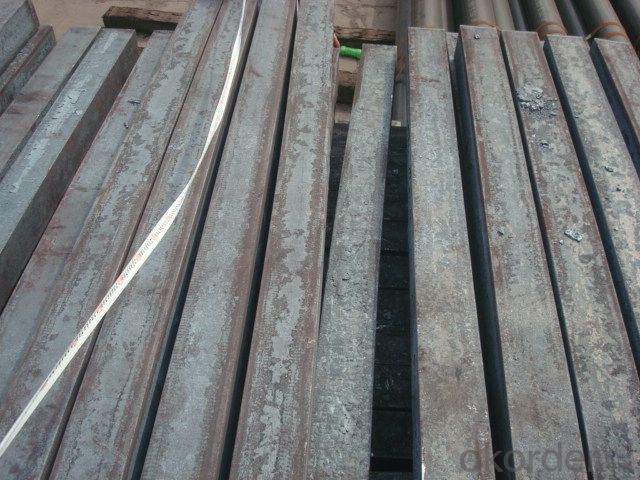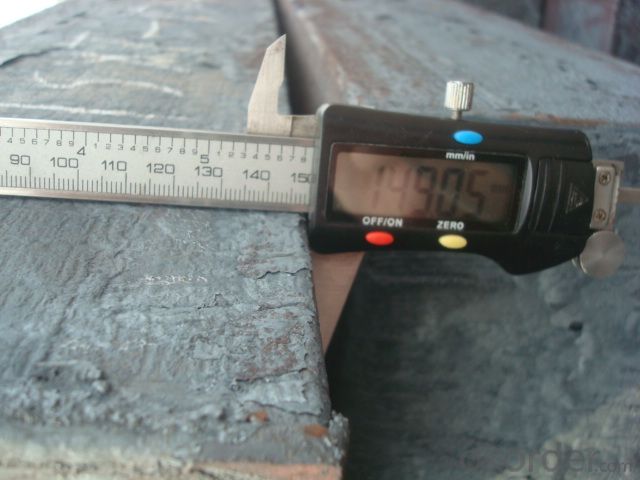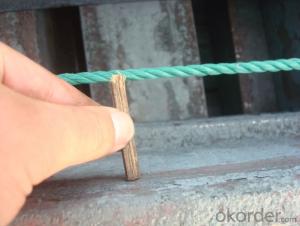Steel Billet Hot Rolled in Amazing Price
- Loading Port:
- Tianjin
- Payment Terms:
- TT OR LC
- Min Order Qty:
- 1000 m.t.
- Supply Capability:
- 50000 m.t./month
OKorder Service Pledge
OKorder Financial Service
You Might Also Like
1.Structure of Steel Billet
Steel billet(ingot) by cogging or breakdown of semi-finished products, is the raw material of all kinds of steel mill. Billet section of square, round, flat, rectangular and abnormity of several kinds of, mainly related to the shape of rolled products.
2.Main Features of Steel Billet
Rectangular billet continuous casting billet and mainly general carbon steel, low carbon low silicon cold-rolled material, high quality carbon structural steel, high strength low alloy steel, special steel, etc.
The billet is mainly divided into two kinds from the shape:
Slab: cross section width and height of the ratio of the larger, mainly used for rolling plate.
Billet: equal cross section width and height, or a huge difference, mainly used for rolling steel, wire rod. ,
Steel billets have distinct characteristics as compared with already furnished steel bars and products. Billets have a specific grain structure, which enables the metal to be processed more intricately. Steel billets are also known for their malleability and ductility, especially when exposed to varying temperatures during shaping and molding.
3.Steel Billet Images


4. Steel Billet Specification
Hot rolled billet steel
Size: 50x50mm-180x180mm
Steel Grade: 3SP, 5SP,Q195,Q235,Q255,Q275 Length:3m-12m
MOQ: 1000MT/size
Payment term: TT or LC
Packing: in bulk , bundle
Shipment: by container , bulk vessel
Packaging Details: bundles with steel strips or as customers's requirements
Delivery time: 15-30 days after the deposit
Loading port:Tianjin, or other port China
Origin :China
Inspection:Third party inspection before loading.
5.FAQ
We have organized several common questions for our clients,may help you sincerely:
1) How about your company?
A world class manufacturer & supplier of castings forging in carbon steel and alloy steel,is one of the large-scale professional investment casting production bases in China,consisting of both casting foundry forging and machining factory. Annually more than 8000 tons Precision casting and forging parts are exported to markets in Europe,America and Japan. OEM casting and forging service available according to customer’s requirements.
2) How long can we receive the product after purchase?
In the purchase of product within three working days, We will arrange the factory delivery as soon as possible. The pecific time of receiving is related to the state and position of customers.Commonly 7 to 10 working days can be served.
3) Can you guarantee the quality of mass production?
Yes, of course. We will send pre-production samples to you for confirmation, after your confirmation we will start mass production. The quality of mass production will be the same as the samples you confirmed to us.
- Q:Can steel billets be used in the automotive industry?
- Yes, steel billets can be used in the automotive industry. Steel billets are semi-finished steel products that are typically used for further processing into different shapes and forms. In the automotive industry, steel billets are commonly used for the production of various automotive components such as engine parts, transmission parts, chassis components, and suspension systems. The use of steel billets in the automotive industry offers several advantages including high strength, durability, and cost-effectiveness. Additionally, steel billets can be easily formed, machined, and welded to meet specific design requirements and performance standards in the automotive sector. Therefore, steel billets play a crucial role in the manufacturing of automobiles and contribute to the overall performance, safety, and reliability of vehicles.
- Q:Can steel billets be polished for improved surface finish?
- No, steel billets cannot be polished for improved surface finish as they are usually unfinished or have a rough surface due to the manufacturing process.
- Q:How are steel billets used in the manufacturing of industrial machinery?
- Steel billets are an essential component in the manufacturing of industrial machinery. These billets are semi-finished products that are produced through a process called continuous casting, where molten steel is poured into a mold to form a solid rectangular shape. Once the steel billets are formed, they undergo various processes to transform them into different components of industrial machinery. One common use of steel billets is in the production of machine parts such as gears, shafts, and axles. These components require high strength and durability to withstand the rigorous demands of industrial applications, and steel billets provide the necessary material properties. Steel billets are also used in the manufacturing of large structural components such as frames, bases, and supports for industrial machinery. These components need to be able to handle heavy loads and provide stability, and the use of steel billets ensures the necessary strength and rigidity. Furthermore, steel billets serve as raw material for forging, where they are heated and shaped using mechanical force to create complex shapes like crankshafts and connecting rods. The high malleability and ductility of steel billets make them ideal for forging, allowing manufacturers to produce intricate and precise components for industrial machinery. In addition, steel billets are often used in the production of specialized machinery, such as rolling mills and presses, which are used in various industrial processes. These machines require robust components that can withstand high temperatures, pressures, and forces, and steel billets provide the necessary strength and resilience. Overall, steel billets play a vital role in the manufacturing of industrial machinery as they provide the necessary strength, durability, and versatility required for producing various components and structures. Their use ensures the reliability and performance of industrial machinery in a wide range of applications.
- Q:How are steel billets used in the production of marine components?
- Steel billets are used in the production of marine components as they serve as the raw material from which various marine parts are manufactured. These billets are heated, shaped, and machined to create components like ship hulls, propeller shafts, engine parts, and other structural elements. By using steel billets, marine manufacturers can ensure the strength, durability, and corrosion resistance required for reliable performance in the demanding marine environment.
- Q:What are the common sizes and dimensions of steel billets?
- Steel billets are produced through continuous casting or hot rolling methods and are semi-finished products. The industry and intended use of the billets determine their sizes and dimensions. While there are common sizes and dimensions used in various applications, they can vary. The size range for steel billets is typically between 100mm and 150mm square. These billets are usually around 6 meters long, but this may differ based on customer needs or the manufacturing process. Round steel billets with diameters ranging from 100mm to 200mm are also commonly produced. The weight of steel billets can range from a few hundred kilograms to several metric tons. The length, cross-sectional area, and density of the steel used determine the weight. Most steel billets fall within the 1 to 5 metric tons range. It is important to understand that these sizes and dimensions can differ among manufacturers, and different industries may have specific requirements. For instance, the automotive industry may require larger or smaller billets based on the parts they produce. In conclusion, steel billets typically have sizes and dimensions between 100mm and 150mm square, with lengths of around 6 meters. Round billets can have diameters ranging from 100mm to 200mm. The weight of a steel billet can vary from a few hundred kilograms to several metric tons. However, it is crucial to consider that these measurements can vary depending on the industry and customer requirements.
- Q:What are the potential applications of steel billets in the defense sector?
- Due to their strength, durability, and versatility, steel billets have numerous potential applications in the defense sector. Here are several examples: 1. Armored Vehicles: Steel billets can be utilized to manufacture the hulls and components of armored vehicles, offering improved protection against ballistic threats and explosive devices. Their high strength and toughness make them suitable for enduring extreme conditions and impacts on the battlefield. 2. Weapon Systems: Steel billets can be incorporated into the production of various weapon systems, such as artillery guns, tanks, and missile launchers. These components require materials capable of withstanding high pressures, heat, and mechanical stresses, all of which steel billets can provide. 3. Defense Infrastructure: Steel billets can be employed in the construction of defense infrastructure, including military bases, bunkers, and fortifications. Their high strength and resistance to corrosion make them suitable for enduring environmental and physical challenges. 4. Naval Applications: Steel billets are crucial in the manufacturing of naval vessels, such as submarines, destroyers, and aircraft carriers. The ability of steel billets to withstand the harsh conditions of the marine environment, including corrosion and pressure, makes them an ideal choice for constructing these vessels. 5. Personal Protective Equipment (PPE): Steel billets can be used to produce body armor, helmets, and other protective gear for military personnel. The exceptional strength and impact resistance of steel billets offer enhanced protection against bullets, shrapnel, and other potential threats on the battlefield. 6. Military Infrastructure: Steel billets can be utilized in the construction of bridges, runways, and other critical military infrastructure. Their high load-bearing capacity and durability ensure the longevity and reliability of these structures, thereby supporting military operations. Overall, steel billets have diverse and crucial potential applications in the defense sector. Their properties make them an invaluable material for various defense applications, ensuring the protection of personnel, equipment, and infrastructure in challenging operational environments.
- Q:How are steel billets used in the manufacturing of wire products?
- Steel billets are used in the manufacturing of wire products by being hot rolled into thin rods or wires, which are then further processed to achieve the desired shape and dimensions. These billets serve as the raw material for wire drawing, where they are pulled through a series of dies to reduce their size and increase their length. This process helps to improve the strength, ductility, and surface finish of the wire, making it suitable for various applications such as construction, automotive, and electrical industries.
- Q:What are the different types of steel billet rolling defects?
- During the rolling process, various defects can arise in steel billets, which can have adverse effects on the final product's quality and integrity. The most commonly encountered types of steel billet rolling defects are as follows: 1. Surface cracks: These are minute cracks that manifest on the billet's surface. They can result from inadequate cooling or excessive rolling pressure. Surface cracks jeopardize the steel's strength and durability. 2. Center cracks: Inner core cracks occur when temperature control during the rolling process is incorrect. Center cracks can lead to structural weaknesses and reduced steel performance. 3. Scalloping: Scalloping refers to the formation of shallow depressions or grooves on the billet's surface. It usually arises due to uneven or improper rolling pressure distribution. Scalloping negatively impacts the steel's appearance and surface quality. 4. Lamination: Lamination defects involve the separation of layers within the billet. They can be caused by the presence of impurities or inclusions in the steel, as well as inadequate heating or rolling conditions. Lamination defects weaken the steel and increase the risk of failure. 5. Wavy edges: Wavy edges occur when the billet's edges become uneven or distorted during rolling. This can be the result of improper alignment or uneven pressure distribution. Wavy edges affect the steel's dimensional accuracy and overall quality. 6. Surface defects: Surface defects encompass scratches, pits, or other imperfections on the billet's surface. They may occur due to insufficient cleaning or handling procedures, as well as improper rolling conditions. Surface defects impact the steel's appearance and surface quality. In conclusion, these steel billet rolling defects hold significant implications for the final product's quality, performance, and safety. Manufacturers must closely monitor the rolling process and implement appropriate quality control measures to minimize the occurrence of these defects.
- Q:What are the potential applications of steel billets in the food and beverage industry?
- Steel billets have several potential applications in the food and beverage industry. They are commonly used to manufacture various types of food processing equipment, such as mixers, blenders, and conveyors, due to their strength and durability. Additionally, steel billets can be used to create storage and transportation containers for food products, ensuring their safety and freshness. The corrosion resistance of stainless steel billets makes them suitable for applications requiring hygiene, such as food preparation surfaces and utensils. Overall, steel billets offer a wide range of possibilities for enhancing efficiency and maintaining high standards of cleanliness in the food and beverage industry.
- Q:What are the main differences between carbon steel and alloy steel billets?
- Carbon steel and alloy steel billets are both types of steel used in various industries, but they have some key differences. The main difference between carbon steel and alloy steel billets lies in their composition. Carbon steel billets are primarily made up of iron and carbon, with carbon content usually ranging from 0.05% to 2.1%. This makes carbon steel relatively more affordable and easier to produce compared to alloy steel. On the other hand, alloy steel billets contain additional elements like manganese, nickel, chromium, and molybdenum, which are added to enhance specific properties of the steel. These alloying elements give alloy steel superior strength, hardness, and resistance to corrosion compared to carbon steel. Another major difference between carbon steel and alloy steel billets is their mechanical properties. Carbon steel billets are generally known for their high ductility and ability to be easily shaped or formed, making them suitable for applications that require flexibility and easy machinability. Alloy steel billets, on the other hand, have higher tensile strength, toughness, and wear resistance due to the presence of alloying elements. This makes alloy steel billets ideal for applications that require high strength and resistance to wear, such as in construction, automotive, and aerospace industries. Furthermore, the heat treatment process for carbon steel and alloy steel billets also differs. Carbon steel billets are often heat-treated to improve their hardness and strength, with common treatments including quenching and tempering. Alloy steel billets, on the other hand, can undergo a wider range of heat treatment processes, including annealing, normalizing, and precipitation hardening. These heat treatments help to optimize the properties of alloy steel billets for specific applications, such as increasing strength or improving machinability. In summary, the main differences between carbon steel and alloy steel billets lie in their composition, mechanical properties, and heat treatment processes. Carbon steel is primarily made up of iron and carbon, while alloy steel contains additional alloying elements. Carbon steel has high ductility and is easily shaped, while alloy steel has superior strength, hardness, and resistance to corrosion. The heat treatment processes for these two types of steel also differ, with alloy steel having a wider range of treatment options.
1. Manufacturer Overview |
|
|---|---|
| Location | |
| Year Established | |
| Annual Output Value | |
| Main Markets | |
| Company Certifications | |
2. Manufacturer Certificates |
|
|---|---|
| a) Certification Name | |
| Range | |
| Reference | |
| Validity Period | |
3. Manufacturer Capability |
|
|---|---|
| a)Trade Capacity | |
| Nearest Port | |
| Export Percentage | |
| No.of Employees in Trade Department | |
| Language Spoken: | |
| b)Factory Information | |
| Factory Size: | |
| No. of Production Lines | |
| Contract Manufacturing | |
| Product Price Range | |
Send your message to us
Steel Billet Hot Rolled in Amazing Price
- Loading Port:
- Tianjin
- Payment Terms:
- TT OR LC
- Min Order Qty:
- 1000 m.t.
- Supply Capability:
- 50000 m.t./month
OKorder Service Pledge
OKorder Financial Service
Similar products
New products
Hot products
Hot Searches
Related keywords





























